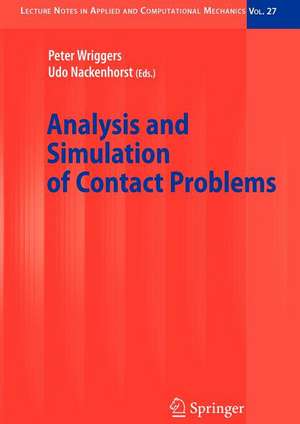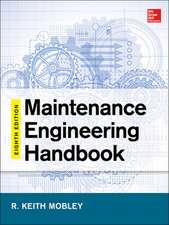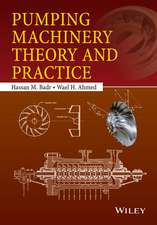Computational Contact Mechanics
Autor Peter Wriggersen Limba Engleză Paperback – 14 oct 2010
| Toate formatele și edițiile | Preț | Express |
|---|---|---|
| Paperback (1) | 1403.63 lei 6-8 săpt. | |
| Springer Berlin, Heidelberg – 14 oct 2010 | 1403.63 lei 6-8 săpt. | |
| Hardback (1) | 1219.33 lei 17-23 zile | +102.74 lei 4-10 zile |
| Springer Berlin, Heidelberg – 22 mai 2006 | 1219.33 lei 17-23 zile | +102.74 lei 4-10 zile |
Preț: 1403.63 lei
Preț vechi: 1711.74 lei
-18% Nou
Puncte Express: 2105
Preț estimativ în valută:
268.67€ • 291.93$ • 225.83£
268.67€ • 291.93$ • 225.83£
Carte tipărită la comandă
Livrare economică 22 aprilie-06 mai
Preluare comenzi: 021 569.72.76
Specificații
ISBN-13: 9783642069048
ISBN-10: 3642069045
Pagini: 532
Ilustrații: XII, 518 p.
Dimensiuni: 155 x 235 x 28 mm
Greutate: 1.25 kg
Ediția:Softcover reprint of hardcover 2nd ed. 2006
Editura: Springer Berlin, Heidelberg
Colecția Springer
Locul publicării:Berlin, Heidelberg, Germany
ISBN-10: 3642069045
Pagini: 532
Ilustrații: XII, 518 p.
Dimensiuni: 155 x 235 x 28 mm
Greutate: 1.25 kg
Ediția:Softcover reprint of hardcover 2nd ed. 2006
Editura: Springer Berlin, Heidelberg
Colecția Springer
Locul publicării:Berlin, Heidelberg, Germany
Public țintă
ResearchDescriere
Contact mechanics has its application in many engineering problems. No one can walk without frictional contact, and no car would move for the same r- son. Hence contact mechanics has, from an engineering point of view, a long history, beginning in ancient Egypt with the movement of large stone blocks, over ?rst experimental contributions from leading scientists like Leonardo da Vinci andCoulomb, to today’s computational methods. In the past c- tact conditions were often modelled in engineering analysis by more simple boundary conditions since analytical solutions were not present for real world applications. In such cases, one investigated contact as a local problem using the stress and strain ?elds stemming from the analysis which was performed for the entire structure. With the rapidly increasing power of moderncomp- ers, more and more numerical simulations in engineering can include contact constraints directly, which make the problems nonlinear. This book is an account of the modern theory of nonlinear continuum mechanics and its application to contact problems, as well as of modern s- ulation techniques for contact problems using the ?nite element method. The latter includes a variety of discretization techniques for small and large def- mation contact. Algorithms play another prominent role whenrobustand- cient techniques have to be designed for contact simulations. Finally, adaptive methods based on error controlled ?nite element analysis and mesh adaption techniques are of great interest for the reliable numerical solution of contact problems.
Cuprins
to Contact Mechanics.- Continuum Solid Mechanics and Weak Forms.- Contact Kinematics.- Constitutive Equations for Contact Interfaces.- Contact Boundary Value Problem and Weak Form.- Discretization of the Continuum.- Discretization, Small Deformation Contact.- Discretization, Large Deformation Contact.- Solution Algorithms.- Thermo-mechanical Contact.- Beam Contact.- Computation of Critical Points with Contact Constraints.- Adaptive Finite Element Methods for Contact Problems.
Recenzii
From the reviews of the second edition:
"The book is not simply a monograph reviewing the author’s distinguished research career, but a true textbook covering the research of the major players in computational contact mechanics over the last 25 years and offers an extensive list of references. … If I were given the opportunity to teach an advanced special topics course on finite element methods, I wouldn’t hesitate to use this book. For a researcher … the text provides an excellent review." (David J. Benson, SIAM Review, Vol. 49 (2), 2007)
"The book is not simply a monograph reviewing the author’s distinguished research career, but a true textbook covering the research of the major players in computational contact mechanics over the last 25 years and offers an extensive list of references. … If I were given the opportunity to teach an advanced special topics course on finite element methods, I wouldn’t hesitate to use this book. For a researcher … the text provides an excellent review." (David J. Benson, SIAM Review, Vol. 49 (2), 2007)
Notă biografică
Peter Wriggers is the internationally most rocognised German scientist in the field of computer-based structural mechanics.
Textul de pe ultima copertă
This is the second edition of the valuable reference source for numerical simulations of contact mechanics suitable for many fields like civil engineering, car design, aeronautics, metal forming, or biomechanics.
Boundary value problems involving contact are of great importance in industrial applications in engineering such as bearings, metal forming processes, rubber seals, drilling problems, crash analysis of cars, rolling contact between car tires and the road, cooling of electronic devices... Other applications are related to biomechanical engineering design where human joints, implants or teeth are of consideration. Due to this variety, contact problems are today combined either with large elastic or inelastic deformations including time dependent responses. Thermal coupling also might have to be considered. Even stability behaviour has to be linked to contact.
The topic of computational contact is described in depth providing an up-to-date treatment of different formulations, algorithms and discretisation techniques for contact problems which are established in the geometrically linear and nonlinear range. This book provides the necessary continuum mechanics background which includes the derivation of the contact constraints. Constitutive equations stemming from tribology which are valid at the contact interface are discussed in detail. Discretization schemes for small and finite deformations are discussed in depth. Solid and beam contact is considered as well as contact of unstable systems and thermomechanical contact. The algorithmic side covers a broad range of solution methods. Additionally adaptive discretisation techniques for contact analysis are presented as a modern tool for engineering design simulations.
The present text book is written for graduate, Masters and PhD students, but also for engineers in industry, who have to simulate contact problems in practical application and wish to understand the theoretical and algorithmic background of contact treatment in modern finite element systems.
For this second edition, illustrative simplified examples and new discretisation schemes as well as adaptive procedures for coupled problems are added.
Boundary value problems involving contact are of great importance in industrial applications in engineering such as bearings, metal forming processes, rubber seals, drilling problems, crash analysis of cars, rolling contact between car tires and the road, cooling of electronic devices... Other applications are related to biomechanical engineering design where human joints, implants or teeth are of consideration. Due to this variety, contact problems are today combined either with large elastic or inelastic deformations including time dependent responses. Thermal coupling also might have to be considered. Even stability behaviour has to be linked to contact.
The topic of computational contact is described in depth providing an up-to-date treatment of different formulations, algorithms and discretisation techniques for contact problems which are established in the geometrically linear and nonlinear range. This book provides the necessary continuum mechanics background which includes the derivation of the contact constraints. Constitutive equations stemming from tribology which are valid at the contact interface are discussed in detail. Discretization schemes for small and finite deformations are discussed in depth. Solid and beam contact is considered as well as contact of unstable systems and thermomechanical contact. The algorithmic side covers a broad range of solution methods. Additionally adaptive discretisation techniques for contact analysis are presented as a modern tool for engineering design simulations.
The present text book is written for graduate, Masters and PhD students, but also for engineers in industry, who have to simulate contact problems in practical application and wish to understand the theoretical and algorithmic background of contact treatment in modern finite element systems.
For this second edition, illustrative simplified examples and new discretisation schemes as well as adaptive procedures for coupled problems are added.
Caracteristici
At the cutting edge of an area of significant (and growing) interest in computational mechanics
Covers the theoretical background of simulations and discusses modern numerical simulation methods
For the second edition, illustrative simplified approaches and new formulations are added
Includes supplementary material: sn.pub/extras
Covers the theoretical background of simulations and discusses modern numerical simulation methods
For the second edition, illustrative simplified approaches and new formulations are added
Includes supplementary material: sn.pub/extras



















